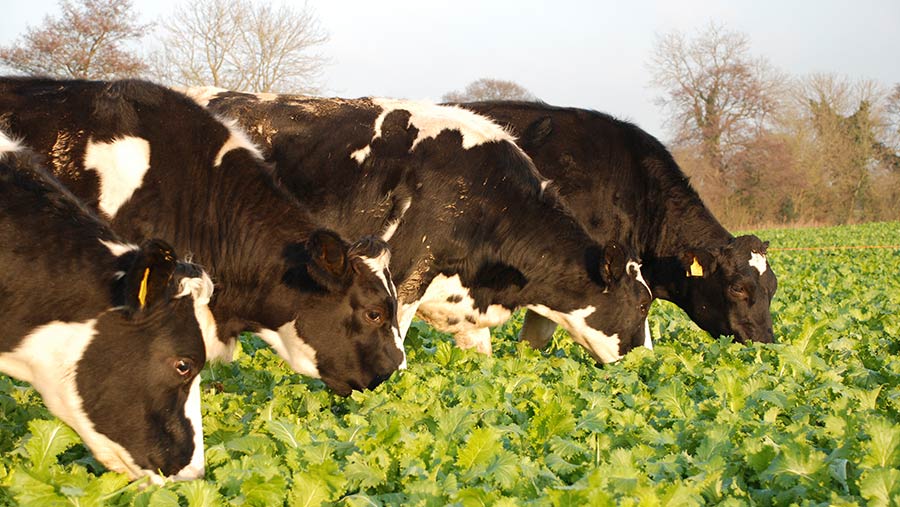Advice for farmers on multi-grazing hybrid brassicas

Demand for hybrid brassicas reached unprecedented levels in 2018 as livestock farmers sought solutions to meet forage shortfalls caused by the drought.
Bred in New Zealand and first grown in the UK about a decade ago, hybrid brassicas are fast-growing, kale x rape hybrids and offer the flexibility of single or multiple grazing.
Germinal GB carried out field studies across four UK sites to establish best practice, including one farm where the practice was to multi-graze hybrid brassicas.
See also: Break crops offer pest control after pesticide restriction
About the 2018-19 field trials
- Four sites included Dorset, Norfolk, Yorkshire, Scottish Borders. Establishment was assessed on all four sites, but the Scottish Borders site was home to a multi-grazing trial.
- Early and later sown crops were investigated
- Yield and quality data, and relative value of leaf and stem, recorded (see table below)
- Stem rejection and grazing preferences between varieties recorded
- The multi-grazing site near Galashiels in the Scottish Borders investigated strategies for a second grazing.
Yield and quality of hybrid brassicas |
|||||
|
Redstart, multiple grazing site in Scotland |
|||||
|
|
DM (t/ha)** |
DM content (%) |
ME (MJ/kg) |
Protein |
|
|
First grazing (leaf) |
4.0 – 6.0 |
12-14 |
12-13 |
20-24 |
|
|
Second grazing |
Leaf |
4.0 |
12.0 |
12.2 |
24.4 |
|
|
Stem* |
4.0 |
15.9 |
11.7 |
11.6 |
|
*Nutritional value of stems sampled in late February was 11.6MJ/kg ME and 17% crude protein, showing a higher than expected quality. **Overall cost of production at multi-graze location was calculated at 3p/kg of dry matter |
|||||
Key learnings are around hybrid brassica establishment and repeated grazing.
Establishment
Key learnings:
- Ensure soil fertility is optimum for best results (pH 6.0 – 6.2, P & K index 2-2+)
- Direct drill to avoid fluffy soils but ensure good soil-to-seed contact (drill seed to a depth of 1cm)
- Drill late April to early June (soil temp 10C min) at seed rate of 2-2.5kg/acre (5-6kg/ha)
- Single-graze crops can be drilled up until early August
- Lay out bales post-drilling to provide fibre (30% of DM intake) when grazing
Multiple grazing – first grazing
At the multi-grazing trial, the site was grazed twice. The field was drilled the first week of June.
The first grazing took place from the third week of August (later than initially planned due to the dry conditions) until November, with 246 finishing lambs in 2ha blocks across 9.4ha (they averaged 9.4kg/head liveweight gain).
Key learnings:
- Budget approximately 2.5% of animal liveweight as daily dry matter intake
- Measure crop available to budget accurately
- Graze in blocks as opposed to strips to minimise stem damage
- Include fibre (silage, haylage or straw) at 30% of DM intake
- Move on to next block after leaf has been grazed (leaving stems), to accelerate the rate of regrowth
- Avoid trampling or excessive damage to maximise regrowth
Multiple grazing – second and final grazing
The second grazing of the 9.4ha was done by breeding rams in 2ha blocks, from December to March.
Average daily growth rates peaked at 243g/day in January and an additional 160 hoggets were turned on in early March to maximise crop utilisation.
Key learnings:
- Lay out more bales as fibre source
- Allow 6-8 weeks for re-growth
- If a third grazing is planned, manage second grazing the same as first.
- Increase block grazing intensity or strip graze on final grazing
- Graze leaf and stem to utilise crop fully
- Do not graze later than March, to avoid flowering and the higher risk of toxicity
- Additional fertiliser was not required between first grazing and regrowth in the trials, although some farmers may need to apply low levels between grazings. Research is on-going to determine any benefits from the application of interim fertiliser
Key benefits
Hybrid brassicas:
- Sowing to utilisation period 10 to 12 weeks
- Useful from summer grazing through to outwintering
- Ideal break crop to minimise pest threat in grassland reseeding
- Good winter hardiness
Multiple grazing:
- Additional dry matter production from same establishment costs
- Amplified break crop benefits
- Higher soil fertility for following crops
- Flexibility throughout the season for different stock classes.
